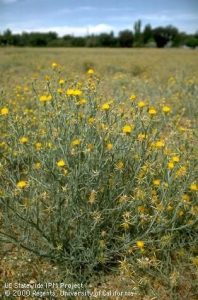Frosts now come later in the fall and end earlier in the spring. Longer seasons and warmer weather combine to be a game changer in the plant wars.
Researchers report that some nonnative plants adjust their flowering schedule faster in concert with the longer growing season. They then elbow out natives while snatching up a greater share of nutrients and water.
According to Bruce Babbit, past Secretary of the Interior, “The invasion of noxious alien species wreaks a level of havoc on America’s environment and economy that is matched only by damage caused by floods, earthquakes, mudslides, hurricanes, and wildfire. These aliens are quiet opportunists, spreading in a slow motion explosion.”
How Do Invasive Plants Spread?
Invasives appear around the world at an ever-increasing speed. Their proliferation is aided by trade, transport, and agriculture. Wind and water further pitch in.
On their home turf, invasive plants are kept in check by natural controls like food and water supply and birds and insects that feed on them. They have been transported to California both intentionally and unintentionally.
Early Spanish explorers introduced water hogging annual grasses that today cover most of our rangeland. Tree of heaven (Ailanthus altissima, brought by Chinese miners, lines streets and blankets hillsides throughout the mother lode.
Some invasives are sold unwittingly in plant nurseries. Gardeners sometimes plant invasives like South American pampas grass, periwinkle (Vinca major) which is perhaps from England, and Mexican feather grass (Nasella tenuissima) without realizing their potentially disastrous results.
Why Worry About Invasive Plants?
Does it really matter if alien plants overrun back yards, fields and forests? The problem: most native insects cannot eat alien plants. Our insects then disappear impoverishing food availability for birds and other creatures. In turn, the food supply is jeopardized for larger and larger animals.
About 75 percent of our food relies directly or indirectly on insect pollinators. If pollinators become out of sync with their food sources, they fade away and the human food supply too diminishes.
Because of their ability to rapidly multiply, invasives can push out native vegetation while scarfing up surface and ground water. They also deplete soil nutrients, accelerate soil erosion, degrade wildlife forage, and decrease diversity of soil biota thereby further reducing soil nutrients.
Disturbed areas are especially vulnerable to invasive invasion; their rambunctious growth and litter can then foster wildfire. Dense stands of Scotch, French, and Spanish broom sport yellow sweet-pea-shaped flowers that are so attractive homeowners often plant them in their yards. Unfortunately brooms can also clog waterways while crowding out native plants, the food source for wildlife.
Automobile tires spread European yellow starthistle seeds willy-nilly along our roadways. Yellow starthistle is one of California’s worst economic and ecological threats that can provide fuel for late summer wildfires and is poisonous to horses.
What Can We Do?
Take immediate action whenever you see bad guys encroaching. Stopping emerging weeds in their tracks makes a tremendous difference in preserving native habitat whether in forests or backyards. Establish instead native plants and biodiversity, including birds and insect pollinators, will follow.
In Washington State, adding native plants to vineyards produced an increase in “good bugs” that in turn helped control insects harmful to the vineyards. Four times more butterflies also emerged!
Replacing thirsty lawns with drought-tolerant natives will provide needed sustenance for countless small wild creatures.
Extensive lists of both California natives and invasives can be found at www.calflora.org/. For additional planting ideas, see their listing for the foothills here..
Contact the University of California Cooperative Extension Master Gardeners of Tuolumne County Hotline at 209-533-5912 (mgtuolumne@ucdavis.edu) for more information and advice.
Each year, University of California Cooperative Extension Master Gardener Vera Strader of Tuolumne County, gives pollinators and other insects a helping hand with her garden’s native plantings.


